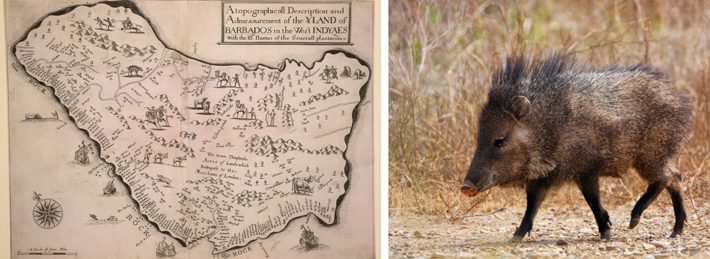Sowing the Land
September/October 2019
 Peccaries, pig-like mammals native to Central and South America, may have been imported to Barbados by Iberian sailors sometime before the 1627 English colonization of the island. While studying a collection of faunal remains held by the Barbados Museum and Historical Society that were excavated in the mid-twentieth century at a colonial domestic site, zooarchaeologist Christina Giovas of Simon Fraser University identified a partial peccary jawbone. The specimen has been radiocarbon dated to between 1645 and 1800, and strontium isotope signatures—which can help determine where a person or animal originated—suggest the peccary spent its whole life on Barbados. Giovas initially suspected that the animal descended from a population introduced by indigenous people who migrated to the island from South America. However, prehistoric human exploitation of animals on Barbados is well documented, she says, and peccaries have never been identified in that record. “The Spanish were aware of the island by the early 1500s,” Giovas explains. “They didn’t settle it, but it’s likely that they stopped by to resupply and acquire fresh water, and in that process probably dropped off peccaries on their way back from South American colonies.” The peccary population may have been hunted to extinction soon after the English arrived.
Peccaries, pig-like mammals native to Central and South America, may have been imported to Barbados by Iberian sailors sometime before the 1627 English colonization of the island. While studying a collection of faunal remains held by the Barbados Museum and Historical Society that were excavated in the mid-twentieth century at a colonial domestic site, zooarchaeologist Christina Giovas of Simon Fraser University identified a partial peccary jawbone. The specimen has been radiocarbon dated to between 1645 and 1800, and strontium isotope signatures—which can help determine where a person or animal originated—suggest the peccary spent its whole life on Barbados. Giovas initially suspected that the animal descended from a population introduced by indigenous people who migrated to the island from South America. However, prehistoric human exploitation of animals on Barbados is well documented, she says, and peccaries have never been identified in that record. “The Spanish were aware of the island by the early 1500s,” Giovas explains. “They didn’t settle it, but it’s likely that they stopped by to resupply and acquire fresh water, and in that process probably dropped off peccaries on their way back from South American colonies.” The peccary population may have been hunted to extinction soon after the English arrived.